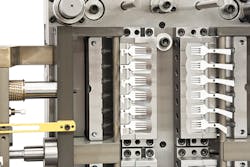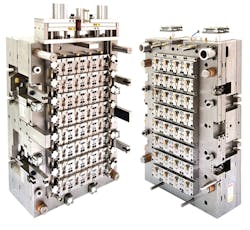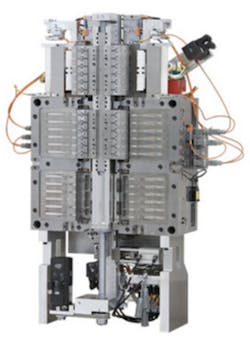NPE: Tools that are changing rules for injection molding
Mold makers at NPE touted concepts that improve mold cooling, further downgauge thin-walled parts and bring downstream insert and assembly operations to the tool without increasing cycle times.
PROPRIETARY
CONFORMAL COOLING
At NPE, tool maker StackTeck Systems Ltd., Brampton, Ontario, launched KoolTrack, used to generate optimal cooling channel geometry for the multi-cavity, high-volume production molds the company designs and builds.
The technology represents StackTeck's own approach to conformal cooling, where cooling lines in the mold follow the contours of the molding surface of the tool. "We have been using different approaches to conformal cooling of simpler parts for several years and we typically find cycle time savings in the range of 10 to 15 percent for sub-10-second cycle times," says Vince Travaglini, VP of engineering.
KoolTrack uses the latest simulation software to model heat transfer in a part and the molding surface of the tool, which enables it to establish optimal cooling channel geometry for a tool design. KoolTrack then uses a new, proprietary steel bonding process StackTeck developed. Intricate cooling channel geometries cut in the mold steel are bonded together to make cores and cavities that have the ideal cooling circuits inside, says Jordan Robertson, GM of business development and marketing. "Conventional cooling channel designs use straight, gun-drilled lines, or incorporate multiple parts that fit together using O-rings to seal the cooling channels," says Robertson.
StackTeck says the bonding technology is as strong as the steel itself, which allows the company freedom to apply cooling wherever it is needed within the mold. StackTeck fine-tuned KoolTrack based on its experience with more than 100 molds.
At NPE, StackTeck displayed a stack component designed to mold cutlery, with a section of the tool cut away to expose the internal complexity of the cooling geometry. As cooling simulation techniques become more effective, KoolTrack will be able to handle even more cooling channel geometries for increasingly complex parts, says Robertson.
StackTeck also enhanced its proprietary Thin Recess Injection Molding (TRIM) technology used in the production of thin-wall packaging. TRIM is based on a mold core design that features raised surfaces that create panels or thin-walled sections of a container. The raised core can be used to create parts with thin or thick sections in the sidewalls and bottom of a part.
Flow modeling allows for the production of lighter parts that have a strength-to-weight ratio equal to or better than conventional parts, says Robertson. Conventional thin-wall designs molded in a high-cavitation tool are typically limited to a length-of-flow average thickness (L/T) ratio of 300:1 or less. The first generation of TRIM offered an L/T ratio up to 500:1. StackTeck has enhanced TRIM to provide longer material flow lengths, delivering an L/T ratio up to 600:1. The new generation of TRIM can mold parts with ultra-thin panels that correspond to a part weight reduction of 30 to 40 percent, says Robertson.
At NPE, StackTeck displayed a single-cavity mold for a 32-ounce tamper-evident rectangular container that has thin-walled TRIM panels covering 90 percent of the sidewall and bottom areas (average L/T ratio was 520:1). TRIM can be used to lightweight thin-wall injection-molded parts to match conventional thermoformed part weights while maintaining traditional features of injection-molded parts, such as bale lugs and tamper-evident features.
StackTeck designs and builds multi-cavity molds for the production of packaging, closures, personal care and medical products. StackTeck offers services such as in-house mold qualification, process validation and full system integration with robotics and automation, as well as system evaluation and in-house training in the setup, operation and maintenance of high-tech molding systems.
MULTI-MATERIAL MOLD CONCEPT
HAS INSERTING OPTIONS
Tool maker Zahoransky Formenbau GmbH, Freiburg, Germany, (represented in the U.S. by Zahoransky USA Inc., West Chicago, Ill.), developed two versions of its patented Servo Cavity Positioning System (SCPS), which is designed for the production of multi-material parts on a standard injection machine.
SCPS is a space- saving alternative to turning stack, double cube, rotary- table or indexing platen concepts used to produce multi-material parts. It does not require the installation of a larger platen in the press for operation, says Alan Trojanowski, product sales manager for molds at Zahoransky USA.
The concept, unveiled a few years ago, arranges each molding process step in a vertical linear arrangement. Molten polymer from each injection unit in the molding cell serves a specific set of cavities in the mold, hence each mold segment features its own cavity geometry and is served by its own hot-runner system, says Trojanowski.
SCPS features a patented, movable and interlocking cavity or core insert indexing system that transfers the insert out from the mold base and away from a set of cavities, repositioning the insert upward, where it is transferred into the next cavity section. A servo-actuated spindle moves the insert sets with the finished parts in them from cavity section to cavity section on the ejector side of the mold. The multi-material part is created as the set of inserts moves to the next cavity set. Finally, the finished part is indexed vertically to a position above the tool for demolding. After the parts are removed, the insert set is then detached from the spindle and attached to a second spindle system installed on the other mold half. The
spindle then transfers the empty insert set down to the bottom end of the spindle (and the bottom of the mold), where it is handed off automatically to the first spindle system.
Zahoransky last year introduced two new versions of SCPS designed for the molding of single-component parts that allow for part assembly and cooling outside the mold. SCPS Light Mould is an alternative to the multi-material paternoster molds. It allows for mold inserts or metal parts to be loaded into cassettes and fed to the injection mold. SCPS Light results in a cycle time reduction as the parts can be transferred sooner while they are retained in their cavities, outside of the molding cycle.
SCPS Flex is an advanced development of SCPS Light that features several operational stations for additional tasks external to the tool. SCPS Flex is modular and can be enlarged and extended with additional stations. Molders can add an insert or metal part in the first station, provide additional cooling to the part in a second station and remove the finished part off the insert in the third station.
SCPS Light and SCPS Flex use an integrated control system developed by Zahoransky that ensures the molds operate independently from the sequential run of the machine. All mold-dependent commands — including activation of all servo axes — come from the control.
Mikell Knights, senior correspondent
Contact:
StackTeck Systems Ltd., 416-749-1698, www.stackteck.com
Zahoransky USA Inc., 630-507-9872, www.zahoransky.com




